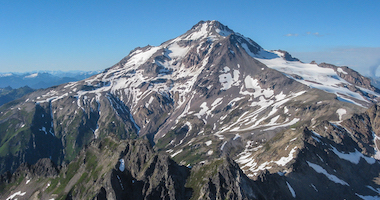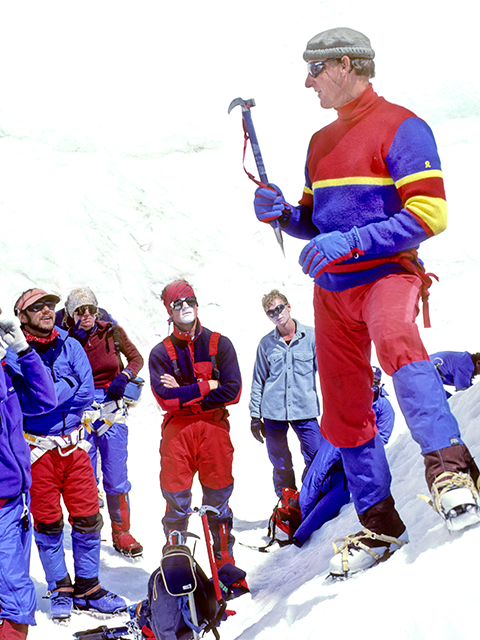Most Popular Entries
May 23, 2015 - 11:00 pm PT
In the real world the saying goes"the early bird gets the worm". This season on
Denali, the early bird gets the weather window. Now I've never been a bird before so I'm not gonna judge on how good a worm must taste, but I have been here before and I can tell you that moving camp in clear weather is much tastier than moving in a storm. So, with a clear but windy morning we scarfed down a warm granola breakfast cached some unneeded gear and quickly broke camp. Our team is getting very proficient at this skill so we were rolling by 9:15. Nick led the team out and in 2.5 hours of sustained up hill travel had us all sitting at 11,200 feet. It wasn't long after we began building a fresh camp that the weather had enough of being nice and took a quick turn for the worst. It held out just long enough to get camp built and then really started snowing and blowing. The forecast is calling for up to a foot of snow by the end of tomorrow so we feel blessed to be in a good spot to wait things out. Everyone sends big hugs to those following the blog and little hugs to those who aren't.
From from Camp three.
RMI Guide Adam Knoff and team saying goodnight.
On The Map
Wednesday, May 20th 6:11 pm PDT
Our day was productive, if not easy. This morning the winds had abated, though not gone, and we seized our opportunity to make some headway. We swapped snowshoes for crampons, packed loads of food and fuel, and roped up for the climb to Windy Corner. The winds, not nearly as strong as yesterday, were nonetheless a bit blustery as we climbed and added a bit of extra challenge to the day, and everyone rose to that challenge. We made it to Windy Corner and cached our loads as the wind seemed to pick up a bit. We scooted back downhill to the comfort of our tents, and tucked in. By mid-afternoon, the winds returned to 11k Camp and brought snow with them. We'll see how the current pattern progresses, and in the morning we'll find out if the weather will allow us to move up, or whether we'll extend out stay at
11,200' for another day. For now we're snug in our beds.
RMI Guides Pete, Robby, Josh, and Team
On The Map
Today we carried half of our gear to the top of Windy Corner. True to it’s name, it was definitely windy. It was great to see the upper part of the mountain though and everyone did great on the carry. It’s definitely a different feeling as one moves up from the camp at 11,200 feet. Below there you feel as if you’re walking amongst mountains; above you feel like you’re really on Denali.
Conditions are really working out in our favor. The snow is great for walking and other than some wind up high the weather is very good.
On The Map
Saint Petersburg!!!
We
traveled all day and have finally arrived in one of the most beautiful cities of Europe. Things went relatively smooth considering we had two van rides and one flight. We got checked into the hotel and then ran out for a quick dinner followed by a short but scenic stroll.
Everyone is very excited to explore and see this city tomorrow.
RMI Guide
Casey Grom and team
Thursday, May 30, 2019 9:33 PM PT
Hello Loyal RMI Blog Followers,
Greetings from 7800’ Camp, aka Camp 1, here on the Kahiltna Glacier. We’ve made the move! After a 3am wake up, our team got up and attem and we were making the first steps of our expedition by 5am. It was an absolute perfect morning for the move up the Kahiltna Glacier. The route was in perfect condition after a solid overnight refreeze, and the temps were ideal for hauling 100 lbs of food and gear across the Alaska wilderness. We made it to camp 1 in great style, pulling in this morning around 10:45. An early arrival allowed us ample time to build camp, settle in for some afternoon naps and enjoy an early dinner of tortellini and the Denali delicacy, Grandma’s Cookies. We’re tucked in the bags now, and hoping for a carry to 10,000’ tomorrow. It appears some snow is on the way for the weekend and into next week, so any chance to make some progress we will gladly take. We’ll keep you in the loop!
RMI Guides Robby Young, Nick Scott, Joe Hoch and Team Parmesan Cheese
This one is going to be brief, I apologize but its been a long day!
We were graced with good weather this morning and we rose early to break down camp and move to 11,000'. The team did a great job moving through the terrain. Light snow flurries kept the temps cool and good for climbing. The final hill into
11,000' Camp is a total butt kicker and the team styled it like pros. The team spent the afternoon building camp and setting up tents before enjoying a well earned meal and a good nights rest. Tomorrow we will travel back down glacier to about 10,000' to retrieve our cached gear and then enjoy having the afternoon free. All is well and the team is doing great!
RMI Guide Steve Gately & Team
June 17, 2017
We've made it! To
Camp 2! It was early, it was snowy, and it was sloggy but we made it! We left camp at 3:45 this morning to stick with our nocturnal schedule and to avoid the post holey conditions. Lucky for us the snow had firmed up and the walking was primo. The visibility on the other hand was little to none, and our only views were those of the rope teams in front of us. We made a few discoveries along the way, for instance uphill travel is much easier without your sled break on! After a few more hours, the occasional bump in the road, and a fair amount of pressure breathing, we pulled into the white expanse of Camp 2. I wish I could tell you views were beautiful but I'll have to wait until the sun comes out! We're now all cozied up in our tents, enjoying some R&R, before a tasty meal of Horiskey Mac and Cheese!
The memories of the slow ascent of Ski Hill are already fading and we are setting our sights on moving to 11,000' tomorrow. Spirits are high and backs are strong!
Until tomorrow,
RMI Guide MIke Haugen and crew
On The Map
June 5, 2015 - 6:53 pm PT
We woke this morning to silence, my first thought was that the weather had become good. Soon I rubbed my eyes and realized the we were completely snowed in. After digging out of the tent we spent another hour excavating camp before we could even start making breakfast. Obviously not a move day.
Once camp was dug out and coffee was coursing through us we spent the day sharing stories, reading, and napping in our tents. The wind and snow let up for most of the afternoon and we are all hopeful that tomorrow will bring good weather for us. The team is antsy to move higher on the mountain but there is nothing we can do about the weather. Spirits remain high and everyone is healthy and happy. Keep your fingers crossed for good weather tomorrow. Thanks for following along with us.
RMI Guide Geoff Schellens
On The Map
Greetings all!
Following our massive breakfast buffet feast in Tlaxcala this morning, our team began the drive towards
Ixta. After a quick food and water refuel in the town of Amecameca, followed by a National Park check in at Paseo de Cortez, we found ourselves at the 12,000' Altzimoni Hut, our home for the evening in preparation of our upcoming two-day climb of Ixta.
In order to continue our process of acclimatization, the team set out for an afternoon hike on the lower slopes of
Ixta. After a quick climb to 14,000', we were rewarded with some amazing views of the sunset on Popocatépetl, an active volcano neighboring closely to the south.
The team is winding down for the evening and preparing for a high-altitude taco feast. We're looking forward to the coming climb and physical test on
Ixta over the next two days. Thanks for following!!
RMI Guides
Zebulon,
Robby, and Team
On The Map
Giddy up! We woke to a chill in the air and ice where there was once a puddle of water. Today we turned off the Vacas Valley and headed up the Relinchos Valley. Several ribbons of water separated us from where we wanted to go. Instead of rolling our pants up and confronting the painfully cold water, we opted to hop onto mules and ride them across. For a brief moment we all got to pretend we were an Argentinean cowboy. Back on two feet, we spent the day making our way to basecamp. The views were jaw dropping and Aconcagua stayed in our view the entire day. Her summit calls but not just yet can we go. First we must rest from a day well done. Tomorrow we will soak in basecamp and also start preparing our loads for our carry to Camp 1 the following day.
Nighty night,
RMI Guide Hannah Smith and team
On The Map
Previous Page
Next Page
.jpg)































Way to go Joe and team! Matt, Suzy, and Lucille are very excited for you and following your adventure. Alice is just thirsty and tired.
Posted by: Suzy on 5/26/2015 at 11:23 am
Way to go, Uncle Joe! We are excited to follow your climb. Good luck.
Posted by: Jedrek & Guthrie on 5/26/2015 at 9:26 am
View All Comments